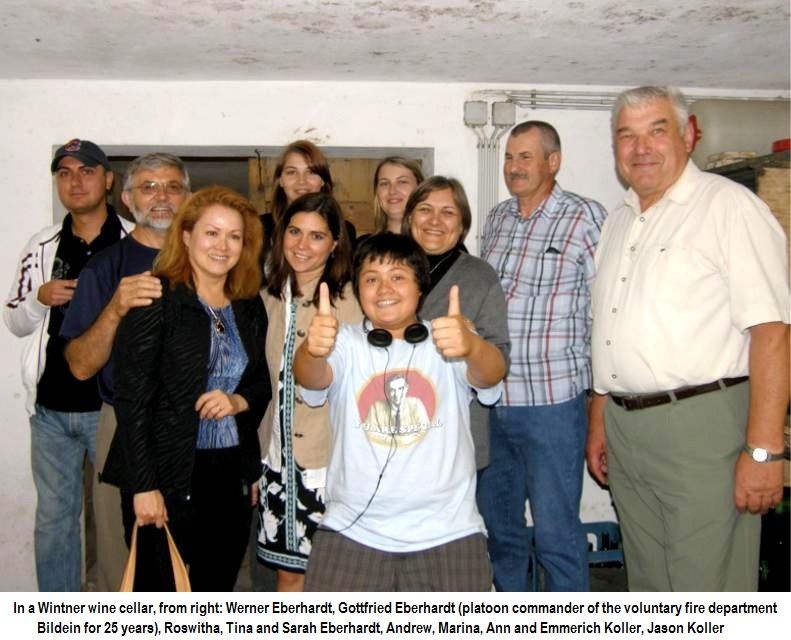|
The
|
THE BURGENLAND BUNCH NEWS - No. 214 October 31, 2011, © 2011 by The Burgenland Bunch All rights reserved. Permission to copy excerpts granted if credit is provided. Editor: Thomas Steichen Our 15th Year. The Burgenland Bunch Newsletter is issued monthly online. It was founded by Gerald Berghold (who retired Summer 2008 and died in August 2008). |
Current Status Of The BB: * Members: 1978 * Surname Entries: 6718 * Query Board Entries: 4736 * Staff Members: 18 |
This newsletter concerns: 1) THE PRESIDENT'S CORNER 2) BILDEIN: THE VILLAGE WITHOUT BORDERS (by Emmerich Koller) 3) PDK: PIANO DUO KUTROWATZ 4) MY JUSTICE IN ACADEMIA WEEK IN AUSTRIA (by Ilse Nusbaum) 5) ENDONYMIC MINORITY NAMES IN BURGENLAND 6) FOLLOW-UP ON A RECENT ARTICLE (BH&R-BASED RESEARCH) 7) BURGENLAND DNA PROJECT UPDATE (by Frank Paukowits) 8) AN AUSTRIAN LAND TRANSFER DECREE 9) HISTORICAL BB NEWSLETTER ARTICLES: WHAT THE BB IS ALL ABOUT 10) ETHNIC EVENTS (courtesy of Bob Strauch & Margaret Kaiser) 11) BURGENLAND EMIGRANT OBITUARIES (courtesy of Bob Strauch) |
1) THE PRESIDENT'S CORNER (by Tom Steichen)  Concerning
this newsletter, we present "Bildein: The Village Without Borders," by Emmerich Koller, as our
featured article (see Article 2). This is a dual report, being both about current-day Bildein and all of its growth and
about the Bildein of 55 years ago... a Bildein that the author still holds dear to his heart. Concerning
this newsletter, we present "Bildein: The Village Without Borders," by Emmerich Koller, as our
featured article (see Article 2). This is a dual report, being both about current-day Bildein and all of its growth and
about the Bildein of 55 years ago... a Bildein that the author still holds dear to his heart.Other articles touch on Piano Duo Kutrowatz, a piano-playing pair of brothers who have reflected some international light on Burgenland (see Article 3), a Jewish Justice in Academia week in Austria (see Article 4), Official Place Names in Burgenland, a complex issue given the multi-ethnic nature of Burgenland (see Article 5) and a follow-up on a Burgenland DNA project (Article 7). In addition, we provide a follow-up on a recent article and a write-up of an interaction with a BB member that just happens to relate peripherally with Article 5. The remaining articles are our standard sections: Historical Newsletter Articles, and the Ethnic Events and Emigrant Obituaries sections. Margaret Kaiser sent a short note concerning ordering of FHC microfilms in the New Jersey area. She said: Effective Wednesday, October 19, 2011, in NJ and nearby states, processing of loaned films at Family History Centers will be changed. Films will be orderable from home with payment by credit card (Master Card or Visa) or by using Paypal. If you do not have an account you can establish one effective October 19. The FHCs will not accept payments, other than copying charges. Caution: If you happen to have a film currently on loan which you plan to renew, please do so by Tuesday. After the conversion, films which have not been extended will not be extended at your local centers. Your short term films will be returned at their posted return date. Thereafter, you may then order them online as a short term or an extended loan. Short term loans will cost $5.50, extended loans are $13.75. Sorry, I don't have more info at this time. More information will be made available, but the above may be of concern to you. Margaret Margaret also sent a note with a link to an web article entitled "Wohin zum Gansl essen…" (Where to eat Goose...). As you may know, November 11 is the day honoring Burgenland's national patron, Saint Martin... and the traditional way to honor him on his Feast day is to "feast" on Martini goose. The question, though, is: Why is goose associated with St. Martin? St. Martin was born 316 AD in Savaria, Pannonia (now Szombathely/Steinamanger, Hungary), the son of a tribune in the Roman army. At age 15, he followed his father's lead and became a Roman soldier. Martin was stationed in Amiens, Gaul (now France), where, as legends tell us: Martin was riding on a cold day, saw a beggar and divided his coat with his sword, giving the beggar half. Martin was then baptized in the Christian faith and continuing serving as a Roman soldier until it became apparent that his career was at odds with the teachings of Christianity. He resigned his post and was imprisoned as a traitor and coward but later released. He then lived the life of a hermit before moving to the city of Tours (France), where he became a disciple of Hilary of Poitiers. Together, they established a monastery and worked for the poor. The citizens of Tours voted for Martin to become their bishop... but Martin, dreading this honor, hid. It was the cackling geese that divulged his hiding place. Martin went on to continue his good works and was eventually elevated to sainthood, becoming the patron saint of Tours as well as Burgenland. As their reward for "outing" Saint Martin, it is now traditional to serve goose on November 11th, roasted crunchy brown in the name of St. Martin. So, if you go to a Martini-fest this month, do enjoy the goose! We recently added a link on the BB Homepage to the Spirit of Gradišće - Őrvidék Group pages, Hannes Graf's website about the ethnic minorities in greater Burgenland. His definition of Gradišće/Őrvidék is "...where Croats, Germans, Hungarians and Gypsy lived together without borders." The website name comes from the Croatian and Hungarian words for Burgenland -- Croatian: Gradišće; Hungarian: Őrvidék. The "Spirit of" portion of the name implies that current borders do not matter. Do stop in and check out what Hannes has been doing over the year since he retired from the BB. BB Member Ed Tantsits, of Allentown, PA, recently shared a joke. There was nothing "Burgenland" about this joke but, since it was a hoot, I've decided to share it with you anyway. However, to Burgenländerize it a bit, I want you to think, while you read it, of a good Burgenland wine and imagine a pair of your Burgenländer ancestors as the couple (if that doesn't help, well then just laugh anyway!).  |
2) BILDEIN: THE VILLAGE WITHOUT BORDERS (by Emmerich Koller)
In the hearts and minds of the people of Bildein, there never existed any borders. |
3) PDK: PIANO DUO KUTROWATZ Earlier this month, Hannes Graf (Spirit of Gradisce - Örvidek Group) distributed a last-minute email note about a piano concert presented by the Austrian Cultural Forum Washington on Tuesday, October 4th, at Alumni Hall on the United States Naval Academy campus in Annapolis, MD. 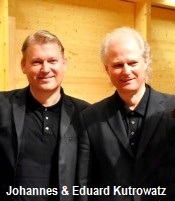 While
it was too late to do anything about attending the event, the notice got me curious about the performers, brothers Eduard
and Johannes Kutrowatz. While
it was too late to do anything about attending the event, the notice got me curious about the performers, brothers Eduard
and Johannes Kutrowatz.First, the notice indicated that both brothers studied piano at the Josef Haydn Conservatory in Eisenstadt, then at the University of Music and Performing Arts in Vienna. It also said that they were the artistic directors of the International Liszt Festival in Raiding, Burgenland. These facts were my impetus to explore further their connection to Burgenland (if any). However, finding connective details proved to be quite difficult... almost at bad as trying to find the home villages of some of our more secretive Burgenland ancestors! I simply wanted to know when and where the brothers were born (much less the names and dates for their wives and children, parents and grandparents and the generations beyond!) Hannes' note indicated that the brothers achieved their first success in international competition in Stresa, Italy, in 1986, with 1st prize in the piano duo class, but that hardly helped. Nor did knowing that "concert tours have taken the Kutrowatz brothers to many European countries, to Asia, Canada, the USA, Australia and Africa." So it was off to a web search... The German Wikiweb reported that "Eduard und Johannes Kutrowatz bilden ein österreichisches, international tätiges Klavierduo. Beide unterrichten an der Universität für Musik und darstellende Kunst in Wien" ("Edward and John Kutrowatz form an Austrian, internationally-active piano duo. Both teach at the University of Music and Dramatic Arts in Vienna"). Well, that confirmed they were Austrian... but where from in Austria? A little further down, the Wikiweb article stated that they "...maturierten am Bundesgymnasium und Bundesrealgymnasium Mattersburg" ("...matured at the Grammar School and Federal Secondary School Mattersburg"), so I had another link to Burgenland... but it did not unequivocally prove birth in Burgenland. However, Wikiweb did provide another tenuous link, indicating that Johannes and Eduard were, since 2001, directors of the annual international chamber music festival Klangfruehling held at Castle Schlaining. A different website told me that "Eduard and Johannes ... grew up in the Austrian Province of Burgenland," but that again did not prove birth. It was not until I stumbled across page http://www.boesendorfer.com/en/archived-news.html?page=3637, the website of the Bösendorfer Klavierfabrik (piano factory) in Wiener Neustadt, that I confirmed Burgenland birth for the brothers. The article (a discreet advertisement for Bösendorfer pianos... which the brothers play and Liszt favored) indicated that the brothers were born in Rohrbach bei Mattersburg. I subsequently found that Johannes was born in 1962 and Eduard a year later in 1963. The Bösendorfer article notes that "...like their model and idol, [Franz Liszt, the brothers are] rooted in the culture and history of this former borderland: formerly western Hungary, now Burgenland, Austria." 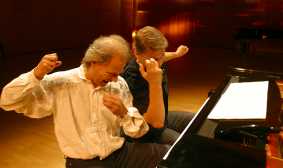 The
international press has also embraced the brothers: "The delicacy of their interpretation cannot be praised highly
enough ... brilliant playing by two exceptional brothers" ... "between meditation and ecstasy" ... "a fiery torrent from
two pianos" ... "pure musicality, coupled with temperament and intelligence" ... "when they play together they seem to
blend into one" ... "a superlative piano duo!" The quality of their performances has been attributed to the breath of
their training and years of experience, however, I think I prefer the interpretive comment by another reviewer: "the
art of piano duet performance requires a measure of constructive dialogue and stimulating debate between the players that
is more readily achieved between siblings." The
international press has also embraced the brothers: "The delicacy of their interpretation cannot be praised highly
enough ... brilliant playing by two exceptional brothers" ... "between meditation and ecstasy" ... "a fiery torrent from
two pianos" ... "pure musicality, coupled with temperament and intelligence" ... "when they play together they seem to
blend into one" ... "a superlative piano duo!" The quality of their performances has been attributed to the breath of
their training and years of experience, however, I think I prefer the interpretive comment by another reviewer: "the
art of piano duet performance requires a measure of constructive dialogue and stimulating debate between the players that
is more readily achieved between siblings."You can hear excerpts of some of their performances on YouTube; for an exuberant example, try http://www.youtube.com/watch?v=0lBr0dVnbvE, but be sure to turn up your volume and expand the picture full screen for the full effect! |
4) MY JUSTICE IN ACADEMIA WEEK IN AUSTRIA (by Ilse Nusbaum) 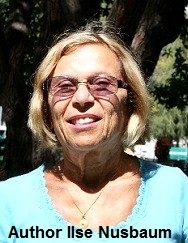 I've
just returned from Austria where my daughter and I spent a week courtesy of the Jewish Welcome Service of Vienna. I'd made
tentative plans to spend a day in Burgenland, but as it turned out, it wasn't possible. What was possible was a visit to
the Vienna University of Economics and Business. I've
just returned from Austria where my daughter and I spent a week courtesy of the Jewish Welcome Service of Vienna. I'd made
tentative plans to spend a day in Burgenland, but as it turned out, it wasn't possible. What was possible was a visit to
the Vienna University of Economics and Business.This is the background: My father, Karl Lowy, taught at the commercial college in Eisenstadt. He received his Diplomkaufmann degree from the university (Hochschule at the time) and expected to receive his doctorate in June 1938. We fled to America in May 1938, among the fortunate few. He lost his degree but always wondered what had become of his dissertation, which had been accepted January 21, 1938. Fast-forward to the anniversary of Kristallnacht in 2009. The director of the Burgenland Memory Project, sent an e-mail. He told me to click a link to Eisenstadt. The surnames of exiles were listed. Our surname was there. On a whim, I Googled my father’s name and Burgenland, and found his dissertation listed in a Wine Bibliography. It had resided in the library of the Vienna University of Economics through destruction and war. The WU library mailed me a copy. 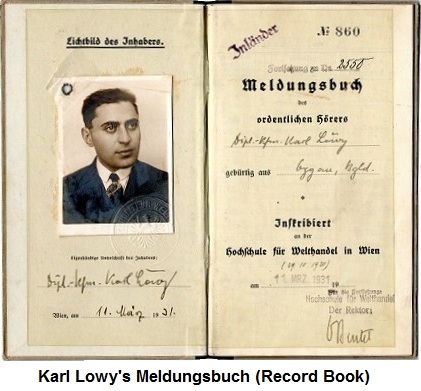 I
wanted more. My father had worked on his doctorate from March 11, 1931 until March 13, 1938. That’s a long time, don’t you
think? I found his Record Book. It seemed to me he’d passed all his exams and that his dissertation had been accepted and
approved. I wanted the university to give him his diploma. Late? Yes. Posthumous? Sadly for him. But in the echo of
California universities that granted belated and posthumous degrees to Japanese students whose schooling had been cut off
soon after Pearl Harbor, it was a matter of Justice in Academia. I
wanted more. My father had worked on his doctorate from March 11, 1931 until March 13, 1938. That’s a long time, don’t you
think? I found his Record Book. It seemed to me he’d passed all his exams and that his dissertation had been accepted and
approved. I wanted the university to give him his diploma. Late? Yes. Posthumous? Sadly for him. But in the echo of
California universities that granted belated and posthumous degrees to Japanese students whose schooling had been cut off
soon after Pearl Harbor, it was a matter of Justice in Academia.On Saturday afternoon, September 10, my daughter and I boarded a plane to Zurich and on to Vienna. We arrived in Vienna on Sunday evening and walked around the city. The weather was warm. Our hotel was in the center of things and we found ourselves on a bustling street full of outdoor cafes. I won’t go into the week’s itinerary. Suffice to say, our hosts kept us busy in ways we could never have done on any other type of tour. But I hadn’t come as a tourist. I was on a mission, to obtain a doctorate for my father posthumously, not knowing how my quest would be received. I thought perhaps it would seem quixotic. Instead it was viewed with understanding and a desire to help. We had a reception with the president of Austria at the Hofburg. As soon as we returned to the hotel, I telephoned the head of the library’s service management department. Fifteen minutes later, she met us at the tram stop and took us into the library. I couldn't have expected a warmer greeting. The Library Director of the Department of Collection of Old Books/Retrospective Conversion had retrieved the original copy of the dissertation. It was in excellent condition. There was one oddity that no one could explain. I suppose it will remain a permanent mystery. As I understand it, the usual procedure was to provide two copies. The signatures of the advisors and the university stamp with the Austrian coat of arms appeared on the backs of the title pages of dissertations submitted before the Anschluss. My father’s dissertation did not have the signatures of his advisors (Hermann Leiter and Bruno Dietrich, coauthors of several books, who apparently kept their faculty positions after the Anschluss), and it had a university stamp with the swastika on the back of the title page. No one seems to know the reason why. The Library Director offered to make a copy for the library archives and give me the original. I was grateful for the generous offer, but declined. I believed the original belonged in the library's archives where it had safely remained for so many decades. We went into the archives and I returned it to its proper place. The next remembrance of my father was seeing his name and the dissertation’s title and library number in the index ledger where it had been written. Next, we were led to the old building where my father had studied. It now houses the Vienna Institute for Archaeological Science, Egyptology (University of Vienna). We went inside and walked around. It was another unexpected pleasure. That evening a package arrived at the hotel. It contained a copy of the dissertation and a CD with a PDF version. I’ve downloaded it onto my computer. Now I have the hard copy and an electronic version to pass along to my children. My desire to have my father honored with a posthumous degree was met with respect. It's my understanding that my request will be looked into, perhaps in November. While walking from the library to the building where my father had studied, our guide told me that she comes from Piesting, where my mother grew up, and that her father remembered my Uncle Rudy who had taken over my grandparents’ medical and dental practice (at the time medical students were required to study dentistry). She also asked why my father had never returned to get his degree. That may seem like an odd question to you, considering we’d been kicked out of the country and forced to sign an affidavit that we’d never return, but I was able to tell her that my parents had intended to return in the fall of 1970. Airline tickets were purchased and plans made to see what had happened to his dissertation. He had a heart attack shortly before they were scheduled to leave. He didn’t survive. I’ve undertaken my filial duty to obtain Justice in Academia. I'll let you know the final outcome. Whether or not it happens, I feel that I've accomplished something important for my brother, children, and grandchildren. Now, home in Los Angeles, I think of my week in Austria, and am happy to share it with you. |
5) ENDONYMIC MINORITY NAMES IN BURGENLAND 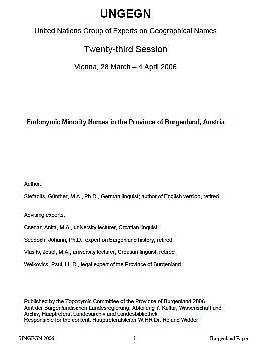 I
recently discovered a publication, titled "Endonymic Minority Names in the Province of Burgenland, Austria," whose
English version was written by Günther Stefanits, PhD, German linguist retired, and published by the Toponymic
Committee of the Province of Burgenland in 2006. It was included as a paper at the UNGEGN (United Nations Group of
Experts on Geographical Names) Twenty-third Session, held in Vienna, 28 March – 4 April, 2006. A pdf of the full paper can
be found by clicking the cover page thumbnail image to the right. I
recently discovered a publication, titled "Endonymic Minority Names in the Province of Burgenland, Austria," whose
English version was written by Günther Stefanits, PhD, German linguist retired, and published by the Toponymic
Committee of the Province of Burgenland in 2006. It was included as a paper at the UNGEGN (United Nations Group of
Experts on Geographical Names) Twenty-third Session, held in Vienna, 28 March – 4 April, 2006. A pdf of the full paper can
be found by clicking the cover page thumbnail image to the right.Despite the paper's obscure title, it contains information that is both interesting, and possibly useful, to those of us doing Burgenland research. First off, it might be helpful to know that UNGEGN defines endonym as "the name of a geographical feature in an official or well-established language occurring in that area where the feature is located." In contrast, they define exonym as the "name used in a specific language for a geographical feature situated outside the area where that language is spoken, and differing in its form from the name used in an official or well-established language of that area where the geographical feature is located." Said more simply, what they are talking about is the name by which the locals call something (endonym) versus what the foreigners call it (exonym). An obvious example for us is that Austria is the English exonym corresponding to the German endonym Österreich. Exonyms and endonyms can refer to the name of a place (toponym), ethnic group (ethnonym), or language (glossonym). Since it is the Toponymic Committee of Burgenland that published this work, it is place names that are of interest in the paper, in particular, field names, street names, and village section names in Burgenland. The paper's (and the Committee's) primary goal is to define the "official" names (plural intended) for such places. As you will see if you read further, the paper establishes the historical reasons for having multiple names for the same place, recites the laws requiring when multiple names are required, and then goes about defining the official spellings and preferred order of use. But the paper also has an extensive section in the Introduction (5+ pages long) that includes basic information about Burgenland ("...total area of 1,531 square miles, 29% forest and 5% vineyards, extending 99 miles from north to south, 2.5 to 37 miles from east to west. ...the climate is mostly Pannonian with an annual average temperature of 50 degrees Fahrenheit and annual precipitation of 26 inches. ...277,600 inhabitants, with age structure 17% under 15 years, 61% from 15 to 60 years, and 22% over 60 years of age. ...colloquial languages are 90% German, 7% Croatian and 2% Hungarian. ...religious affiliation is 82% Roman-Catholics and 14% Protestants", etc.). The Introduction also includes an excellent historical section beginning in prehistoric times ("...the oldest tool finds in the region are approximately 10,000 years old ...in the Bronze Age, ore was already being mined at the Güns Mountains," etc.) and extending into 2005. These parts of the Introduction alone makes the paper worth reading. The next sections of the Introduction fully describes the ethnic/language groups ("...about 85% of its 277,570 inhabitants only speak German, approximately 25,000 people speak and understand Croatian, 16,500 speak Hungarian, and about 4,000 speak Romanes; approximately 15% of the population are bi- or multilingual") and the religious/language groups ("...the great majority of German-speaking believers, practically all Croats and Roma, are Roman Catholic, the Lutheran Protestants are all German speaking, the Reformed Protestants are all Hungarian speaking. All municipalities with a Hungarian majority or a strong Hungarian minority are Reformed Protestants with the exception of Siget in der Warth..."). The Introduction then discusses the legislation that defines minorities and when and where multi-language names are required. These laws compel that "names and inscriptions of topographical nature attached by regional authorities or by other corporations and institutions of public right..." must be provided in specific languages that vary from village to village depending on the minority makeup of that village. (These same laws require that official government business must be transactable in the specified languages also.) Only now does the paper get to its "Exposition" section, wherein it gives some official names and the logic by which those names were defined. This section is much like the BB's Village pages, wherein we give the village names in German, Hungarian and Croatian (when appropriate). The logic section is also similar to the many discussions that have appeared in the BB newsletter about the meaning and/or origins of a surname. Interestingly, the author notes that "...among the Croatian place names we find new Croatian names, translations from either German or Hungarian and lingual distortions from either German or Hungarian as well." The author even indicates some Croatian names being adopted from the German but "heavily distorted." This section does provide Roma (Romanes) names for 42 villages (something the BB Village pages do not supply but perhaps now will). The author notes that "Roma place names have not been thoroughly researched into yet" so only those fully researched are provided. The Exposition then addresses regional, street and field names. It states that "A special field of area names is the range of agriculture: soil in the shape of farmland, fields and meadows has accumulated so many expressions not only in German, but also in Croatian and Hungarian, that these field names have become a treasure of old and traditional names in all the languages found in the Burgenland." It is my opinion that this section may prove useful in understanding some obscure words found in old records. The Exposition closes with comments on "New Challenges" in establishing place names, especially those brought in with the influx of Turkish workers in the last 15 years. These workers (and their families) have not yet integrated into Burgenland society but constitute up to 25% of some village populations. They will eventually create new names for Burgenland places that will need to be incorporated into the official nomenclature. The body of the paper is some 28 pages long but is an easy, fairly quick read. In addition, the paper has a 40 page Appendix that contains both many interesting tables supporting and supplementing the facts given in the Introduction and the lists of official names defined by the Committee. Finally, there is a 5 page Annex that lists Ethnic Non-Government Organizations that have influence in the development of the multi-ethnic "language" of Burgenland. While this may seem to be an obscure paper, I found it to be quite interesting; you may too. Ed Note: I asked Klaus Gerger, a Burgenland resident, about his experience with minority signage in Burgenland. He reports that "in practice the implementation of the law worked out smoothly in Burgenland. We have bilingual Ortstafeln (city limit signs) as stated in the article. Some names, e.g., of the fire station or kindergarten, are also bilingual but that's it basically. To my knowledge, it has no impact on companies. In other provinces, especially Carinthia, it is a matter of constant argument and the signs are not implemented yet." |
6) FOLLOW-UP ON A RECENT ARTICLE (BH&R-BASED RESEARCH) Bob Gollinger, of Prescott, Ontario, Canada, wrote in response to my article about BH&R-based research, He said: Thanks for the newsletter and interesting articles. Two of my relatives are listed in "Burgenländers Buried at Cemeteries in Eastern Pennsylvania": Trinkle, Joseph Königsdorf 1860 1933 Sacred Heart Allentown Trinkle, Julia (Preinsperger) Königsdorf 1869 1954 Sacred Heart Allentown I have written the Church for more information but no reply. Where do you suggest I research from here? Cheers I replied: Hi Bob, I'm not surprised at the lack of response from the church... the ministers are busy and genealogy ranks low on their priority list. So, I'd start with Ellis Island records and confirm arrival and home village... Julia Trinkl, age 29 of Königsdorf, and two sons, Rudolf & Karl, ages 6 & 2, arrived Mar 3, 1898 aboard the SS Friesland from Antwerp (departed Feb 21) to join husband / father, Josef Trinkl in Allentown, PA, see Ellis link here. Are these the right family? However, I cannot find Josef's arrival. Then I'd confirm via census records... The 1900 US Census for Lehigh Co, PA, shows a Joseph Drinkle, (born Mar 1870) with wife Julia (b Apr 1868), sons Rudolf (b Apr 1891) and Charlie (b Dec 1896), and daughter Julia (b. PA, Jan 1899) on Rail Road Street in Allentown. Joseph emigrated 1897, the rest 1898. The notable things here are Josef's birth year and emigration year... Given those, I find a Josef Trinke, aboard the SS Westernland, arriving Feb 10, 1897 from Antwerp. He is 27, a Hungarian (no city given) going to Allentown. However, further down the census page is a Joseph Drinkle (b Jan 1860) from Austria with wife Julia (b Nov 1866) and sons Aulph (b Dec 1889) and Rudolph (b Apr 1893) plus nephew Randolph (b Oct 1882). Joseph, Julia and Aulph emigrated 1892. This census record certainly adds confusion... so, is this, or the first one, your family? This seems to be the first problem you must resolve. As to Königsdorf, the BB Houselists (http://www.the-burgenland-bunch.org/HouseList/JE/Koenigsdorf.htm) show one Preinsperger and 8 Trinkl households in 1858 Königsdorf... so this seems reasonable. Given that, I'd go to the microfilmed church records to sort out your family. Catholic records (1828-1895) are on films 700675 and 700676 (split at 1870). Lutheran records are with Eltendorf, film 700738 for 1855-1889 births (there are also more years plus marriage and death records, but I'd start with this film). These are available through Mormon Family History Centers (FHC's), Go to page http://www.familysearch.org/eng/library/FHC/frameset_fhc.asp and put in your address to find the nearest one. I would think the above would be a good start at tracking down this family line, however, I have copied the BB staff to see if they can add anything. Thanks for the kind words about the Newsletter. Bob wrote back to me with more information but included some information that he wanted held confidential. As we heartily try to honor such confidentiality requests, I wrote back to him suggesting some edits to remove the sensitive material, as I wanted to share the other additional information with the BB staff. The message below incorporates our joint edits: Bob wrote: I'm assuming the burial page shows my relatives. I have forwarded my message and yours to two related folk, one who grew up in Spinnerstown and the other in Allentown. Interestingly enough, the latter's Deutsch mother married a Trinkl - the maiden name of her grandmother. Neither is now in the Allentown area and the former does genealogy research, so I asked them for help. My father had a half brother who lived in Allentown: Frank Deutsch - 910 North Penn Street. My father's mother, Juliana Trinkl, was married to Frank's father, who subsequently died, and she then remarried, this time to one Franz Göllinger, listed as from Heiligenkreuz? (I have also found references for his being from Langzeil.) My grandmother, Juliana, had a brother Josef but I could not learn from Burgenland relatives what happened to him. Two books have now helped: "Unsere Geschichte: Königsdorf von dem Anfängen bis 1900 (Kurzfassung)" and "Unsere Wurzeln: Stammbäume, Häuser, Heiraten der Königsdorfer." It is from these books that I realized my grandmother's brother immigrated to Allentown, or at least to the USA. From the books, I also gleaned the house number, 146, of my grandmother's Trinkl family. Josef, born 1870 (burial page below 1860), in 1893 married Juliana Preinsperger, born 1868 (burial page below 1869), from House number 43, also in Königsdorf. There is a notation -> USA ? An aside: My research in the books shows no incidence of a protestant (E) or Catholic (K) marriage. Burgenländers Buried at Cemeteries in EASTERN PENNSYLVANIA Trinkle, Joseph Königsdorf 1860 1933 Sacred Heart Allentown Trinkle, Julia (Preinsperger) Königsdorf 1869 1954 Sacred Heart Allentown I am trying to relate these two sources of information. The information/date is slightly different on the burial page and in the book. 1860 versus 1870 for Joseph and 1869 versus 1868 for Juliana. Although birth dates differ, it would be difficult to find two people of the same names and from the same village for whom there is a complementary congruent pair of persons at approximately the same time. And on a completely different tangential note: This summer we found the location of my great grandfather Göllinger's home in Kleinmürbisch. My Königsdorf cousin and I used the Burgenland Village lists - House # 6 in 1858, to establish the location before going. The woman remembered the story of her grandfather buying the house from my great grandfather around 1870. The latter grew fruit and chestnuts and made wine, all of which he sold to workers in Szentgotthárd, Hungary. The entire village, including house # 6, was destroyed by fire in 1944 by the Russians. The woman was the widow of one Karl Marx! Bob Strauch replied: If this is the right Trinkle family, here are the dates their obits appeared in the Morning Call: Trinkle, Joseph - 4/15/34, p. 7 Trinkle, Julia (Preinsberger) - 4/4/54, p. 55 Trinkle, Adolf - 3/15/55, p.10 Margaret Kaiser also replied: Here is what I find in census and other records. 1930, 109 Chew Street, Allentown, PA TRINKLE Josef, head, homeowner, value $6K, has radio, age 70, married at age 32, born Austria, parents b. Austria, mother language German, immigrated 1892, naturalized, cabinet maker, furniture factory. Julia, wife, age 63, married at age 26, born Austria, parents b. Austria, mother language German, date immigrated unknown, naturalized, no occupation. This unknown info about Julia seems to indicate someone other than she provided this information. Since both are listed as naturalized you should consider obtaining copies of their naturalization documents which would provide birth dates and hometowns as well as other significant information. 1920 census, 109 Chew Street, Allentown, Pa TRINKL Joseph, Head, homeowner, age 60 not mortgaged, age 60, immigrated 1892, naturalized 1902, b. Hungary, cabinet maker, furniture. Julia, wife, age 53, immigrated 1896, naturalized 1902, b. Hungary. Rudolph, son, age 26, immigrated 1896, naturalized 1902, b. Hungary, salesman, music store. at same address: TRINKL Adolph, Head, Head, age 30, immigrated 1896, naturalized 1902, b. Hungary, electrician, steel co. Theresa, wife, age 27, immigrated 1912, naturalized 1902, b. Hungary Julia, daughter, age 4/12s, b. PA I'd [guess that] Adolph is the son of Joseph and Julia. Likewise that Joseph, Julia and children were naturalized on the same document back in 1902. Based on above, I found the 1917 WW1 draft registration for Rudolph J. Trinkle, born April 1, 1893 in Allentown, church organist at First Pres. Church, dependents his parents, objects on religious grounds Note: There are other Rudolph Trinkle listed. One is born August 27, 1892 and was from Konigsdorf. Another Rudolph Trinkle age 29 was born April 12, 1888 in Koningsdorf. Adolf Trinkle, of 2301 So. 12th Street, is listed as 51 from Koningsdorf, born Dec. 30 1889; nearest contact is Mrs. Theresa Trinkle at same address. (dated 1942, WW2 registration) |
7) BURGENLAND DNA PROJECT UPDATE (by Frank Paukowits)  A DNA
project study solely for Burgenländers was launched early this year. As indicated in the February BB Newsletter, the
Project is being hosted by Family Tree DNA and Frank Paukowits (BB Member) is coordinating activities. As of this October,
24 people were participating in the Project. All have had their DNA tested and preliminary results have been obtained and
reported to the Project’s participants. A DNA
project study solely for Burgenländers was launched early this year. As indicated in the February BB Newsletter, the
Project is being hosted by Family Tree DNA and Frank Paukowits (BB Member) is coordinating activities. As of this October,
24 people were participating in the Project. All have had their DNA tested and preliminary results have been obtained and
reported to the Project’s participants.Here are some observations from a macro perspective: Burgenland is ethnically / genetically very diverse, just like Central Europe and especially like Hungary. It can best be characterized from a genetic standpoint as a “mixing bowl." Secondly, Eastern European DNA is somewhat more dominant than Western ones, suggesting either that conquering “German-speakers” subdued a large ethnically Slavic population or, contrarily, that a continuous Slavic influx has diluted the “German blood,” which is the more likely scenario based on the written history of this area. Also, the share of Balkan-types is high compared with Germany proper. The more people who participate in the Project, the more meaningful the results will be. Unfortunately, participation in the Project is not cost-free. All participants must pay to have their DNA tested, which is a requirement to participate in the Project. If you have any interest in knowing more about your ancient family roots, get in touch with Frank Paukowits at paukowits1@aol.com. He can provide details on what is involved. |
8) AN AUSTRIAN LAND TRANSFER DECREE BB Member, Sue Salmon, of Minneapolis, MN, sent me a note asking for an opinion about a document she has concerning a Burgenland land transfer that took place in the 1950s. She said that "My great grandfather, Samuel Fink, left all of his grandchildren shares of the land that he owned in Markt Allhau. One grandchild, Joseph Fink, who lived in Buchschachen, asked his cousins, three sisters and a brother, who lived in St. Paul, Minnesota, for their shares of the land." 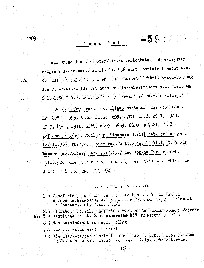  The
document Sue had was an official Burgenland government notification, in the form of a legal decree, that the right of
possession of the shares of land held by the cousins was transferred to Josef Fink. The document indicated that the basis
for the transfer was a deed of donation executed and witnessed in 1956 in Oberwart, a "special authorization" signed in
1954 in St. Paul, and a certificate of "no objection" by the Internal Revenue Service in Vienna. You can view scans of the
German text (left) and its English translation (right) by clicking the thumbnails here. The
document Sue had was an official Burgenland government notification, in the form of a legal decree, that the right of
possession of the shares of land held by the cousins was transferred to Josef Fink. The document indicated that the basis
for the transfer was a deed of donation executed and witnessed in 1956 in Oberwart, a "special authorization" signed in
1954 in St. Paul, and a certificate of "no objection" by the Internal Revenue Service in Vienna. You can view scans of the
German text (left) and its English translation (right) by clicking the thumbnails here.Sue's question was whether this document might be useful in her search for other family. In particular, she was looking for "any living family of Joseph... He was born Jan 18, 1908 and died Jun 24, 1983. He married Theresa Ritter on Feb 9, 1929. She was born Nov 20, 1907 and died Feb 22, 1979. Is there anyway to know if he sold it or left it to a family member? I know that he married, but have been unsuccessful at finding out if he had any children. There are Fink's still living in Buchschachen and Markt Allhau, but no luck." My reply was that "this sounds like an interesting document and is worth understanding better, even if it does not lead to additional family members. I’m willing to do what I can to get you help with it." Then I noted that "I know too little about Austrian land transfers to know whether this document might prove useful. However, I can consult the more Austrian-knowledgeable members of the BB staff to see what they know… I’d speculate that the Austrian system is somewhat similar to the American system in that the equivalent of a deed must document each legal transfer of land. That “deed” will name the parties involved and identify the land but is unlikely to indicate family relationships (if any) between the parties. Thus, a transfer to a married female family member or a cousin might not be obvious. Deeds in the US are quite searchable, so I’d guess that would be true of the Austrian documents too, but you’d have to be in the repository itself to do that." So I sent a message to the BB staff sharing Sue's questions and a copy of the document, specifically asking if: 1) Can such a document help track down relatives? And, if yes, 2) How would one do so? I also noted that these "quite small shares (3/80th) seemed to be a fairly unusable amount of land. I’d be interested in your thoughts on this too." Klaus Gerger replied that the "attached document is just a sort of official notification that the endowment of the Portners [the cousins] to Josef Fink is legal; that is, that there are no financial or legal hindrances. To your questions: 1) yes [it can be helpful] 2) you have all the names and addresses and you have the plot numbers. With that info, one can query at the cadastral register in Oberwart and find out the current and former owners of the land (there is a little charge for printing out that information)." Klaus also pointed out that "on an internet-based GIS (http://gis.bgld.gv.at/WebGIS/synserver?project=Kataster) you can find the location of the lots on a map" and he provided an example image captured from this system (see below).  He also noted that "the answer to your question, if that split up was common, is yes. It was one of the reasons Burgenländer had to emigrate. Plots were too small to feed a family. There was an extra name for those kinds of fields: Belt fields (or Hosenriem Äcker, where Hosenriem is the Heanzisch word for the German word Gürtel)." So, as I expected, the Austrian system is quite similar to American system. Like many places in the US, there is a Geographic Information System (GIS) available to help map each of these lots. It is yet another tool that may prove useful to the BB membership in understanding the land our forefathers trod. Although Klaus did not show it, there was an additional window that showed a bit more information (though, unfortunately, it does not show the owner's name). In particular, it shows the total area in meters squared [column Fläche (m2)] and it shows the field name [column RiedName]; see below: I mention the first item so you can get a sense of size of the lot. In this case, 1187 meters squared translates (in American terminology) into an area equal to a square with 112 feet per side... not very big! I mention the second item, the field name, because this is one of the items mentioned in Article 5 above that is subject to endonymic minority naming conventions. (I can't say I can precisely translate "Kleine Örtl" but I think it means something like "small place" or "small quarter", obviously in German.) Klaus' reply was passed on to Sue. She says she will email him about more information on who to contact at the cadastral register in Oberwart and any fees involved. I do hope she shares her finding with us as she pursues this line of research! |
9) HISTORICAL BB NEWSLETTER ARTICLES Editor: This is part of our occasional series designed to recycle interesting articles from the BB Newsletters of 10 years ago. THE BURGENLAND BUNCH NEWS No. 100 October 31, 2001 WHAT THE BB IS ALL ABOUT Between 1850 and 1950, over 50,000 people emigrated from the area now known as the Burgenland. Some called their homeland Western Hungary (pre 1921), some called it Austria (post 1921), some called it Vas Megye, or Austria-Hungary or the district in which their village was located, such as Szt. Gotthard or Güssing or Neusiedl. Whatever they called it, they were our parents, grandparents or ancestors. They were of German, Croatian, Slovenian, Hungarian and Gypsy (Roma) origin. They were Catholic, Lutheran, Calvinist and Judaic. There is no complete official record of these immigrants, yet it is possible that today there may be as many as 11 million descendants. Many would like to trace their ancestry. There are problems to doing this, not the least of which is language. There are 16,000 books on Burgenland history, written in German and Hungarian, but there are almost none in English. Burgenland as a political entity is only 80 years old, but its history spans 2000 years. Most villages date to medieval times and their names have frequently changed. Family names have likewise undergone change in the records that have been kept. There are over 400 Burgenland villages but they are small (under 1 or 2 thousand inhabitants) and don't appear on most maps. Many are no longer individual municipalities and parish and civil records have moved. Church and civil records from 1828-1921 have been microfilmed by the LDS (Mormon Church) and they are available at family history centers, but reading German and Hungarian script and archaic terms can be difficult. US Census records for 1910, 1920 and 1930 identify immigrant families if residence is known, but much listed data is inconclusive. Ellis Island records have been digitized but are fraught with misspellings. An Austrian organization, founded in 1956, called the Burgenländische Gemeinschaft, with headquarters in Güssing, continues to link immigrant families to the homeland via a newsletter and periodic meetings and social functions, but require language proficiency and ocean crossings. The long-time president of this organization and editor of its newsletter, Dr. Walter Dujmovits, has written a definitive primer of this Burgenland migration (Die Amerika-Wanderung der Burgenländer), but it is in German. Records prior to 1828 are available but their location is often obscure. Most Austrian families have lost track of their American cousins and many American descendants are not aware they have Austrian relatives. Many would like to make a trip to Burgenland and look for their ancestral villages or relatives, but don't know how. With the advent of the home computer and the internet, both here and abroad, the time and tools to address these problems arrived. For this reason the BB was formed in 1997 by a small group of Burgenland descendants. Our purpose is to address the previously mentioned problems, establish a database of Burgenland immigrant families (3000 to date) [Ed.: now over 6700] and provide an archive of English language articles concerning Burgenland history and culture. We identify and address areas of original research which shed light on the lives of our ancestors. We provide English language translations of here-to-fore untranslated material. We do this by offering membership to descendants (800 to date) [Ed.: now approaching 2000] and listing and archiving their family data and maintaining same on an internet website. We coordinate our efforts through a volunteer staff and tie it all together with a monthly internet email newsletter. In this way we hope to expand Burgenland family history, memorialize the memory of our immigrant ancestors and retain links with their homeland. |
10) ETHNIC EVENTS LEHIGH VALLEY, PA (courtesy of Bob Strauch) Saturday, November 5, 10 am-2 pm: - Ethnic Food Festival/Bazaar at Queenship of Mary R.C. Church (formerly Our Lady of Hungary) in Northampton. Sunday, November 6, 9am-1pm: Bazaar at St. Stephen of Hungary R. C. Church in Allentown. First Tuesdays, Nov 1, 5:30-7:30 pm: All you can eat Buffet. Entertainment by Carl Heidlauf on Piano. ~ Open to the Public ~ $10 ($12 guests). Lancaster Liederkranz, 722 S. Chiques Rd, Manheim, PA. lancasterliederkranz@verizon.net, 717-898-8451. Saturday, Nov 12: Military Ball. ~ Open to the Public. Lancaster Liederkranz. Musical Entertainment by George Tarasek Orchestra. Saturday, Nov 19: Stiftungsfest. Lancaster Liederkranz. Music by Heidi und Heimat Echo. NEW BRITAIN, CT (courtesy of Margaret Kaiser) Friday, Nov 4, 7 pm: Heimat Abend. $3. Austrian Donau Club, 545 Arch Street, New Britain, CT, (860) 223-9401. Music by Joe Rogers and his band. Hot food is available from the kitchen. Saturday Nov. 12, 6 pm: Schnitzel Dinner. Austrian Donau Club. Scha-Musi will perform along with a performance by the Alpenland Dancers. Tickets $20 in advance. Children under 12 half price. Sunday, Nov 13, 8 am - Noon: Sonntag Frühstuck. Austrian Donau Club. Come enjoy breakfast. Friday, Nov 18, 7:30 pm: Heurigan Abend. $3. Austrian Donau Club. Music by Schachtelgebirger Musikanten. Hot food is available from the kitchen. Friday, Nov 25, 7 - 10 pm: Fifth Friday. Austrian Donau Club. Featuring Frank Billowicz. German musical entertainment and food will be available. Tuesdays at 7 pm: Men's and Women's Singing Societies meet. Austrian Donau Club. Thursdays at 7 pm: Alpenland Tänzer (Alpine Country Dancers) meet. Austrian Donau Club. |
11) BURGENLAND EMIGRANT OBITUARIES (courtesy of Bob Strauch) Anna Schatz  Anna M.
(Reichardt) Schatz, age 102, of Conshohocken, PA, died on Tuesday, October 11, 2011. She was born in Güssing, Burgenland,
Austria on May 2, 1909, the daughter of the late Joseph and Anna (Mikowits) Reichardt. Anna M.
(Reichardt) Schatz, age 102, of Conshohocken, PA, died on Tuesday, October 11, 2011. She was born in Güssing, Burgenland,
Austria on May 2, 1909, the daughter of the late Joseph and Anna (Mikowits) Reichardt.Anna was the beloved wife of the late Rudolph Schatz for 54 years. Anna was born and raised in Austria, coming to the United States in 1936 when she was 27 years old. She was a licensed driver in Austria at a time when one had to be proficient in engine repair to receive an automobile driver's license. As a cook for the director of a large steam ship line in Austria, Anna held many talents in cooking and baking, which she shared with family and friends. Anna supported her family holding various jobs in domestic service. She was a parishioner of St. Matthew's Roman Catholic Church in Conshohocken, where she also held the distinction of being its eldest member. She also enjoyed knitting, crocheting and gardening: her rose bush, which was transplanted from her previous parish in Philadelphia and tended to daily for decades, still produces a beautiful array of roses from April through November. Above all, Anna thoroughly enjoyed being the matriarch of her family. Anna is survived by a son, Rudolph J. of Conshohocken; a daughter, Anne Hill of Fort Washington; 14 grandchildren and 4 great-grandchildren. She was predeceased by a brother, Frank and 2 sisters, Margaret and Charlotte. Relatives and friends may pay respects on Monday morning, October 17, from 8:30-10am at the William A. Moore Funeral Home, 708 Fayette St., Conshohocken. A funeral mass will commence in St. Matthew Roman Catholic Church, 3rd Ave. & Fayette St., Conshohocken. Interment, Calvary Cemetery in West Conshohocken. In lieu of flowers, the family requests donations in Anna's memory be made to the charity of one's choice. Published in The Times Herald on October 14, 2011. Lester Mogdics  Lester
Mogdics, age 83, of Ravenna, Michigan, died Saturday, October 15, 2011 at Great Lakes Specialty Hospital Hackley Campus. Lester
Mogdics, age 83, of Ravenna, Michigan, died Saturday, October 15, 2011 at Great Lakes Specialty Hospital Hackley Campus.Lester was born on November 4, 1927 in Schandorf, Burgenland, Austria to the late John and Anna (Muhr) Mogdics. He married Rosemary (Petti) Mogdics on July 3, 1954 in Chicago, IL. Lester worked at the S.D. Warren Paper Mill for 42 years until his retirement in 1990. Lester is survived by 1 son, Michael Mogdics of Ravenna; 3 grandchildren, Josh (Angie) Ryan of Grand Rapids, Jessica Mogdics and Kevin Mogdics both of Ravenna; 2 great grandchildren, Joshua Ryan Jr. and Ava Ryan; 1 brother, John (Anna) Mogdics of Muskegon and several nieces and nephews; several cousins in Schandorf, Austria also survive. Funeral Services for Lester Mogdics will be conducted on Thursday, October 20, 2011 at 10:30 AM at St. Catherines Catholic Church in Ravenna with Father Fred Brucker celebrant. Burial will follow at St. Catherines Catholic Cemetery. The family will be at the Throop Funeral Home of Ravenna on Wednesday, October 19, 2011 from 2:00 to 4:00 PM & 6:00 to 8:00 PM to receive friends. Memorials may be directed to: Go to: www.throopfhravenna.com to sign the online guestbook. The Throop Funeral Home of Ravenna is in charge of funeral arrangements. 231-853-6511 Published in Muskegon Chronicle on October 17, 2011 Carl Anthony Wagner  Carl
Anthony Wagner, 89 of Vacaville, California, passed on Friday, Oct. 14, 2011, at VacaValley Hospital in Vacaville. Carl
Anthony Wagner, 89 of Vacaville, California, passed on Friday, Oct. 14, 2011, at VacaValley Hospital in Vacaville.He was born Oct. 21, 1921, in Gaas, Burgenland, Austria, the son of the late Rudolph and Katherine (Preissler) Wagner. Mr. Wagner was retired from the United States Postal Service as a mail carrier for 15 years. A career military person and a World War II veteran, he served 30 years in the United States Air Force, 45th Infantry Division, where he was awarded a Purple Heart, a Bronze Star and received a U.S. Air Force Commendation. He ranked as a chief master sergeant, and NCOIC Security Police at Travis Air Force Base in Fairfield. Mr. Wagner is survived by his loving wife of 62 years, Eleonora; and two brothers, Louie and Albert of Allentown, Pennsylvania. He was preceded in death by two sisters, Maria and Anna; one brother, Alfred; and both parents. Friends are invited to attend the funeral, which will be held at Bryan-Braker Funeral Home, 1850 W. Texas St., Fairfield, California, on Monday, Oct. 24, from 11:30 a.m. to 1 p.m. Interment will be at Rockville Cemetery, 4219 Suisun Valley Road, Fairfield. Published in The Reporter on October 21, 2011 |
END OF NEWSLETTER |
NOTICE (Terms and Conditions): The Burgenland Bunch (BB) was formed and exists to assist Burgenland descendants in their research into their heritage and, toward that end, reserves the right to use any communication you have with us (email, letter, phone conversation, etc.) as part of our information exchange and educational research efforts. • If you do not want your communication to be used for this purpose, indicate that it is "confidential" and we will abide by that request. • Correspondents who communicate with the BB without requesting confidentiality retain their copyright but give a non-exclusive license to the BB allowing us to forward to BB members, publish in our monthly newsletter or on our website, and/or subsequently and permanently archive all or parts of such communications. The Burgenland Bunch homepage (website) can be found at: http://www.the-burgenland-bunch.org/ Burgenland Bunch Newsletter, copyright © 2011 by The Burgenland Bunch All rights reserved. Permission to copy excerpts granted if credit is provided. |
 News
News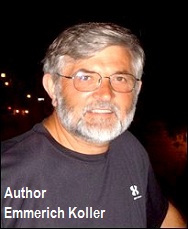 This
past summer, my family and I spent a few days in and around Bildein and we can vouch for the accuracy of the description
above. I would like to first acquaint my readers with this beautiful spot on earth, the village itself and the nice people
that live there. My second purpose for writing this article is to highlight an event in the history of Bildein that was of
great significance to my family and me 55 years ago.
This
past summer, my family and I spent a few days in and around Bildein and we can vouch for the accuracy of the description
above. I would like to first acquaint my readers with this beautiful spot on earth, the village itself and the nice people
that live there. My second purpose for writing this article is to highlight an event in the history of Bildein that was of
great significance to my family and me 55 years ago.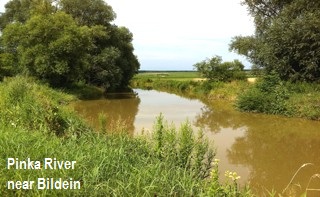 During
four long decades, the Iron Curtain divided the Pinka Valley that had been home to German, Hungarian and Croatian speaking
people for hundreds of years. Bildein is one of the German-speaking villages in this valley. Since the removal of that
infamous barrier, the people of Bildein have made it their goal to remove all barriers that exist in the mind. In 1993,
Oberbildein and Unterbildein were merged into one single community. As a single community, they have dedicated themselves
to the concept of “the village without borders.” They are resolved to strive for open-mindedness towards everything new,
for openness towards guests and tourists of all ages, and for tolerance towards different ethnic groups, religions and
languages. At the same time, Bildein wishes to draw attention to the history of the border, to life on the border, and to
life with its Hungarian neighbors. Much has happened in this regard in Bildein, which distinguishes it from its neighbors.
During
four long decades, the Iron Curtain divided the Pinka Valley that had been home to German, Hungarian and Croatian speaking
people for hundreds of years. Bildein is one of the German-speaking villages in this valley. Since the removal of that
infamous barrier, the people of Bildein have made it their goal to remove all barriers that exist in the mind. In 1993,
Oberbildein and Unterbildein were merged into one single community. As a single community, they have dedicated themselves
to the concept of “the village without borders.” They are resolved to strive for open-mindedness towards everything new,
for openness towards guests and tourists of all ages, and for tolerance towards different ethnic groups, religions and
languages. At the same time, Bildein wishes to draw attention to the history of the border, to life on the border, and to
life with its Hungarian neighbors. Much has happened in this regard in Bildein, which distinguishes it from its neighbors.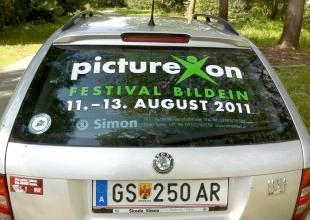 From
August 11–13 of this year, 2,500 rock music fans met once again on the grounds of the village center of Bildein for the
annual “limitless” music festival Picture On. This spectacle of music is organized by the Kulturverein
Grenzgänger of Bildein with the cooperation of KuKuK of Bildein, Novamusic Entertainment and
Grandisce of Szentpéterfa, Hungary. The entire community is also actively engaged in the successful running of this
huge event. Since the first concert in 2000, the festival has been expanded each year so that now there are two open-air
bandstands and the number of attendees has grown tenfold. In the meantime, the festival has become part of a much wider EU
project (see
From
August 11–13 of this year, 2,500 rock music fans met once again on the grounds of the village center of Bildein for the
annual “limitless” music festival Picture On. This spectacle of music is organized by the Kulturverein
Grenzgänger of Bildein with the cooperation of KuKuK of Bildein, Novamusic Entertainment and
Grandisce of Szentpéterfa, Hungary. The entire community is also actively engaged in the successful running of this
huge event. Since the first concert in 2000, the festival has been expanded each year so that now there are two open-air
bandstands and the number of attendees has grown tenfold. In the meantime, the festival has become part of a much wider EU
project (see 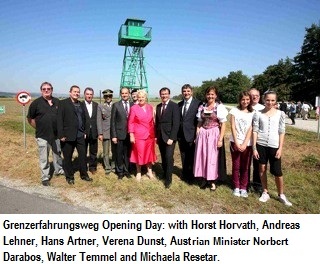 Exactly
one month later, on September 11, the Grenzerfahrungsweg—the border experience walk—was officially opened. This
path, which is about five kilometers long, has a number of stations that bring to life the history of the village and the
region since World War II and invites guests to actively participate in the experience. It is a singular tourist
attraction, conceived and designed by the artist Andreas Lehner.
Exactly
one month later, on September 11, the Grenzerfahrungsweg—the border experience walk—was officially opened. This
path, which is about five kilometers long, has a number of stations that bring to life the history of the village and the
region since World War II and invites guests to actively participate in the experience. It is a singular tourist
attraction, conceived and designed by the artist Andreas Lehner.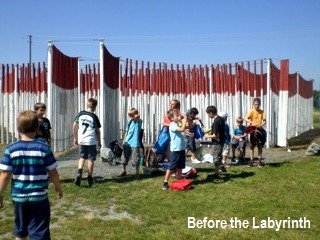
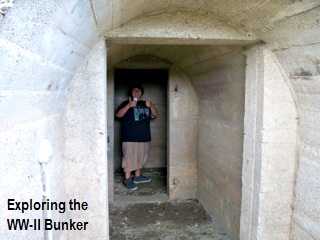
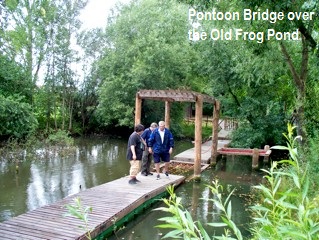
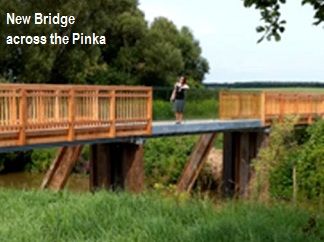
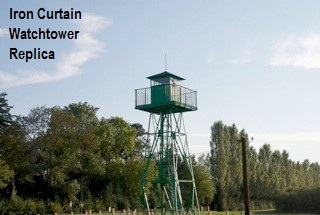 From
this point on, a new path, constructed with the help of the Austrian army, takes the visitors north along the Pinka River
to the Austrian-Hungarian border, where a beautiful new bridge spans the river with views into Hungary. On the other side,
the path returns south to the village and to a final station featuring a replica of a Hungarian border watchtower and a
section of the old Iron Curtain. The walk offers much more than what I have described and I recommend a visit to Bildein
if, for no other reason, than to experience this unique tourist attraction.
From
this point on, a new path, constructed with the help of the Austrian army, takes the visitors north along the Pinka River
to the Austrian-Hungarian border, where a beautiful new bridge spans the river with views into Hungary. On the other side,
the path returns south to the village and to a final station featuring a replica of a Hungarian border watchtower and a
section of the old Iron Curtain. The walk offers much more than what I have described and I recommend a visit to Bildein
if, for no other reason, than to experience this unique tourist attraction.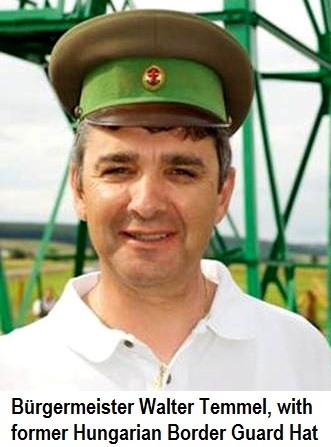 The
Grenzerfahrungsweg is but the newest addition to Bildein; however, it is quite extraordinary how much
more has been accomplished in the last 20 years. These things didn’t just happen by themselves, of course. They were
made possible with financial support from the EU, the vision of a very capable and charismatic young mayor and Bundesrat
delegate, Walter Temmel, the efforts of the man behind the scene who makes things happen, Emmerich Zax, and the
dedicated determination of the people of Bildein.
The
Grenzerfahrungsweg is but the newest addition to Bildein; however, it is quite extraordinary how much
more has been accomplished in the last 20 years. These things didn’t just happen by themselves, of course. They were
made possible with financial support from the EU, the vision of a very capable and charismatic young mayor and Bundesrat
delegate, Walter Temmel, the efforts of the man behind the scene who makes things happen, Emmerich Zax, and the
dedicated determination of the people of Bildein.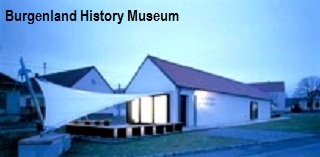 In
the center of Unterbildein is the Burgenländische Geschichte(n)haus—the history house/museum of Burgenland—that
recounts and illustrates the history of Bildein as well as personal stories from the various phases of the border. A visit
to this museum would be the perfect introduction, or even conclusion, to a walk along the Grenzerfahrungsweg.
In
the center of Unterbildein is the Burgenländische Geschichte(n)haus—the history house/museum of Burgenland—that
recounts and illustrates the history of Bildein as well as personal stories from the various phases of the border. A visit
to this museum would be the perfect introduction, or even conclusion, to a walk along the Grenzerfahrungsweg.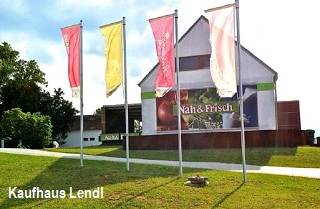 best wines of the local vintners are stored. The old parish barn was first remodeled into a performance and communications
center then expanded to include a hall for events, a restaurant (Rosemaries Gasthaus) and a store (Kaufhaus Lendl) with a
section for local products. To catch all these facets of this center in one word, the locals settled on WeinKulturHaus.
My American family learned to appreciate the fine southern Burgenland cuisine in this Gasthaus and we can recommend it to
all visitors to Bildein.
best wines of the local vintners are stored. The old parish barn was first remodeled into a performance and communications
center then expanded to include a hall for events, a restaurant (Rosemaries Gasthaus) and a store (Kaufhaus Lendl) with a
section for local products. To catch all these facets of this center in one word, the locals settled on WeinKulturHaus.
My American family learned to appreciate the fine southern Burgenland cuisine in this Gasthaus and we can recommend it to
all visitors to Bildein.